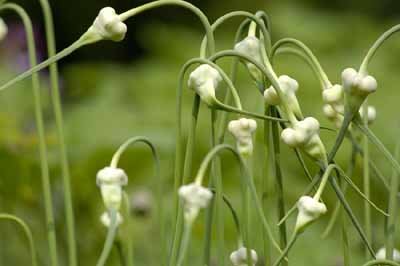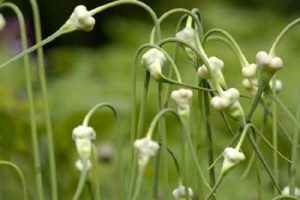One Last Thing to Plant: Garlic
Garlic scapes: the other harvest
By Thomas Christopher
This is the season when my wife and I do our last planting of the year: garlic. This may be my favorite vegetable crop, although I also love growing tomatoes, starting the seedlings in spring and then trellising the vines, I hate the pests and diseases they attract. Last summer, a family of porcupines repeatedly climbed the fence to devour most of our harvest, and I was driven to the indignity of buying tomatoes to make the pasta sauce that I freeze and save for winter supper. Nothing much bothers the garlic, though. And it grows right through the winter, its green shoots re-emerging every time the snow melts to reassure me that spring will come.
You’ll need a sunny spot to grow garlic and a deep, organic-rich soil. We amended our heavy clay with bags and bags of used coffee grounds from a café at the university where my wife works. You can accomplish the same thing, though, by digging in a couple of inches of compost. This is beneficial for sandy as well as clay soils. Be sure to loosen the soil to a depth of at least 8 inches – 12 inches is better. Be sure to test your soil before planting; garlic prefers a pH of 6.2 – 7.0, and if your soil is more acidic than that, as it often is in the Northeast, you’ll want to raise the pH by adding lime or wood ashes. Wood ashes, incidentally, have the advantage of also adding potassium, an essential plant nutrient, to the soil. A soil test, though, available from your local Cooperative Extension or from your states’ agricultural university, will tell you exactly what fertilizers and other additives your soil needs to grow garlic.
Don’t rely on left-over cloves of grocery store garlic to plant your patch. These are of varieties best adapted to growth in California, the home of our big commercial garlic farms, and the cloves may have been treated with a growth inhibitor to make them last longer on the shelf. Instead, get “seed garlic” from a supplier whose stock is certified nematode-free. Nematodes, tiny worms that parasitize the garlic and distort its growth, are the only serious pest the home garlic-grower is likely to encounter, but can be easily avoided in this manner.
There are many different varieties of garlic, with colorful names such as ‘Inchelium Red’ and ‘Persian Star.’ All fall into two basic types, though: softneck and hardneck. Softneck types have softer central stems that make them easier to braid and the bulbs last longer in storage. My wife and I typically grow hardneck types, however, because they succeed better in cold climates. Our current favorite is ‘Montana Zemo’ which makes large bulbs with just a few fat cloves.
Another advantage of the hardneck garlics is that they typically bolt in early summer, sending up curling flower stalks. These are best clipped off so that the plant devotes all of its energy to fattening its bulb. If cut when young, the scapes have a mild and sweet garlic flavor and a texture like asparagus, and are wonderful in stir fries.
Planting is simple. Separate the bulbs into individual cloves and insert them in the soil, pointed side up, four inches deep and six to eight inches apart. Rotate your planting into a new area every fall, allowing two or more years to elapse before replanting in an area where garlic has been grown previously.
Care of garlic is simple. Keep the plants weed-free – garlic doesn’t compete well with weeds – and give them a sprinkling of some balanced and complete fertilizer in mid spring when they are growing most energetically. Wait until the leaves yellow, usually in late July, then loosen the soil with a spading fork before pulling the bulbs out by their stalks. Lay them out to dry for two weeks in an airy spot protected from the sun and rain. Gently brush any soil off the bulbs, taking care not to damage the papery skins, then braid the stems like a little girl’s pigtails. Hardnecks are more difficult to braid than softneck types but not impossible. Hang the braids up in a cool, dry place, and the garlic should remain fresh and plump for six months or more.
Thomas Christopher is the co-author of “Garden Revolution” (Timber Press, 2016) and is a volunteer at Berkshire Botanical Garden. berkshirebotanical.org
Be-a-Better-Gardener is a community service of Berkshire Botanical Garden, one of the nation’s oldest botanical gardens in Stockbridge, MA. Its mission to provide knowledge of gardening and the environment through 25 display gardens and a diverse range of classes informs and inspires thousands of students and visitors on horticultural topics every year. Thomas Christopher is the co-author of Garden Revolution (Timber press, 2016) and is a volunteer at Berkshire Botanical Garden. berkshirebotanical.org.



